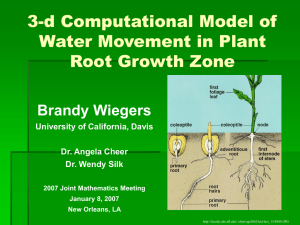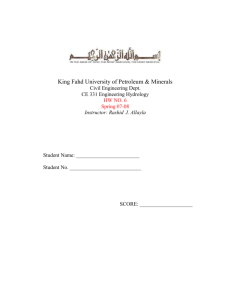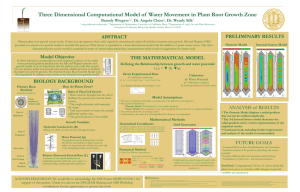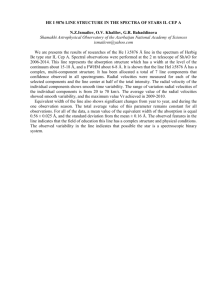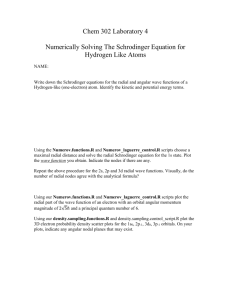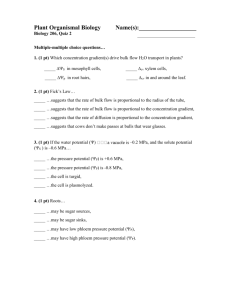Presentation
advertisement
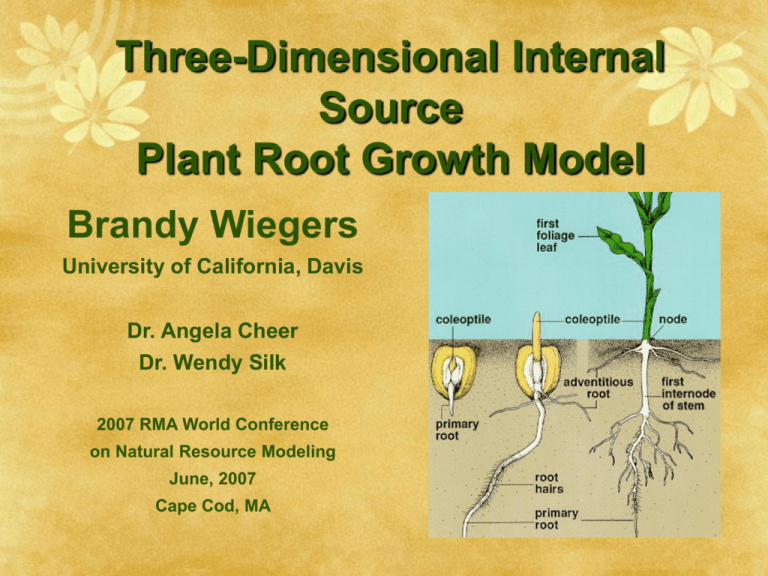
Three-Dimensional Internal Source Plant Root Growth Model Brandy Wiegers University of California, Davis Dr. Angela Cheer Dr. Wendy Silk 2007 RMA World Conference on Natural Resource Modeling June, 2007 Cape Cod, MA http://faculty.abe.ufl.edu/~chyn/age2062/lect/lect_15/MON.JPG Research Motivation http://www.wral.com/News/1522544/detail.html http://www.mobot.org/jwcross/phytoremediation/graphics/Citizens_Guide4.gif QuickTime™ and a TIFF (LZW) decompressor are needed to see this picture. Photos from Silk’s lab How do plant cells grow? Expansive growth of plant cells is controlled principally by processes that loosen the wall and enable it to expand irreversibly (Cosgrove, 1993). http://www.troy.k12.ny.us/faculty/smithda/Media/Gen.%20Plant%20Cell%20Quiz.jpg Water Potential, w w gradient is the driving force in water movement. w = s + p + m Gradients in plants cause an inflow of water from the soil into the roots and to the transpiring surfaces in the leaves (Steudle, 2001). http://www.soils.umn.edu/academics/classes/soil2125/doc/s7chp3.htm Hydraulic Conductivity, K Measure of ability of water to move through the plant Inversely proportional to the resistance of an individual cell to water influx Think electricity A typical value: Kx ,Kz = 8 x 10-8 cm2s-1bar-1 Value for a plant depends on growth conditions and intensity of water flow http://www.emc.maricopa.edu/faculty/far abee/BIOBK/waterflow.gif Relative Elemental Growth Rate, L(z) A measure of the spatial distribution of growth within the root organ. Co-moving reference frame centered at root tip. Marking experiments describe the growth trajectory of the plant through time. Streak photograph Marking experiments Erickson and Silk, 1980 Relationship of Growth Variables L(z) = ▼· (K·▼) (1) Notation: Kx, Ky, Kz: The hydraulic conductivities in x,y,z directions fx = f/x: Partial of any variable (f) with respect to x In 2d: L(z) = Kzzz+ Kxxx + Kzzz+ Kxxxx (2) In 3d: L(z) = Kxxx+Kyyy+Kzzz +Kxxx+Kyyy+Kzzz (3) Given Experimental Data Kx, Kz : 4 x10-8cm2s-1bar-1 - 8x10-8cm2s-1bar-1 L(z) = ▼ · g Erickson and Silk, 1980 Boundary Conditions (Ω) zmax y = 0 on Ω Corresponds to growth of root in pure water rmax rmax = 0.5 mm Zmax = 10 mm Solving for L(z) =▼·(K·▼ ) (1) L(z) = Kxxx+ Kyyy + Kzzz+ Kxxx + Kyyy + Kzzz (3) Known: L(z), Kx, Ky, Kz, on Ω Unknown: Lijk = [Coeff] ijk The assumptions are the key. (4) Osmotic Root Growth Model Assumptions The tissue is cylindrical beyond the root tip, with radius r, growing only in the direction of the long axis z. The growth pattern does not change in time. Conductivities in the radial (Kx) and longitudinal (Kz) directions are independent so radial flow is not modified by longitudinal flow. The water needed for primary root-growth is obtained only from the surrounding growth medium. 3D Osmotic Model Results *Remember each individual element will travel through this pattern* Analysis of 3D Results Model Results Longitudinal gradient Radial gradient Empirical Results Longitudinal gradient has been measured No radial gradient has been measured Phloem Source Gould, et al 2004 Internal Source Root Growth Model Assumptions The tissue is cylindrical beyond the root tip, with radius r, growing only in the direction of the long axis z. The growth pattern does not change in time. Conductivities in the radial (Kx) and longitudinal (Kz) directions are independent so radial flow is not modified by longitudinal flow. The water needed for primary root-growth is obtained from the surrounding growth medium and from internal proto-phloem sources. 3D Phloem Source Model Comparison of Results Osmotic 3-D Model Results Internal Source 3-D Model Results My Current Work… Sensitivity Analysis Looking at different plant root anatomies, source values, geometry, and initial value conditions. Plant Root Geometry r = 0.3mm:0.5mm:0.7mm Plant Root Geometry Proto-phleom Placement 2.1 mm from tip, 4.1mm, 6.1mm from tip, no source Hydraulic Conductivity Kr: 4 x10-8cm2s-1bar-1 Kr: 4 x10-8cm2s-1bar-1 - 8x10-8cm2s-1bar-1 Source, 4.1 mm No Source Hydraulic Conductivity Kr: 4 x10-8cm2s-1bar-1 Kr: 4 x10-8cm2s-1bar-1 - 8x10-8cm2s-1bar-1 Source, 2.1 mm No Source Growth Boundary Conditions Soil vs Water Source, 2.1 mm No Source Summary: Growth Analysis Radius: increase in radius results in increase of maximum water potential and resulting gradient Phloem Placement: The further from the root tip that the phloem stop, the more the solution approximates the osmotic root growth model Hydraulic Conductivity: Increased conducitivity decreases the radial gradient Growth Conditions: Soil vs Water Conditions play an important role in comparing source and non source gradients End Goal… Computational 3-d box of soil through which we can grow plant roots in real time while monitoring the change of growth variables. Thank you! Do you have any further questions? Brandy Wiegers University of California, Davis wiegers@math.ucdavis.edu http://math.ucdavis.edu/~wiegers My Thanks to Dr. Angela Cheer, Dr. Wendy Silk, the RMA organizers and everyone who came to my talk today. This material is based upon work supported by the National Science Foundation under Grant #DMS-0135345 Grid Refinement & Grid Generation
